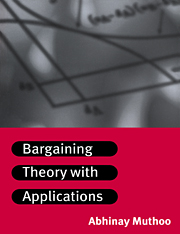2 - The Nash Bargaining Solution
Published online by Cambridge University Press: 24 November 2009
Summary
Introduction
A bargaining solution may be interpreted as a formula that determines a unique outcome for each bargaining situation in some class of bargaining situations. In this chapter I study the bargaining solution created by John Nash. The Nash bargaining solution is defined by a fairly simple formula, and it is applicable to a large class of bargaining situations — these features contribute to its attractiveness in applications. However, the most important of reasons for studying and applying the Nash bargaining solution is that it possesses sound strategic foundations: several plausible (game-theoretic) models of bargaining vindicate its use. These strategic bargaining models will be studied in later chapters where I shall address the issues of why, when and how to use the Nash bargaining solution.
A prime objective of the current chapter, on the other hand, is to develop a thorough understanding of the definition of the Nash bargaining solution, which should, in particular, facilitate its characterization and use in any application.
In the next section I define and characterize the Nash bargaining solution of a specific bargaining situation in which two players bargain over the partition of a cake (or ‘surplus’) of fixed size. Although this type of bargaining situation is not uncommon, a main purpose of this section is to introduce — in a relatively simple and concrete context — some of the main concepts involved in defining Nash's bargaining solution.
Information
- Type
- Chapter
- Information
- Bargaining Theory with Applications , pp. 9 - 40Publisher: Cambridge University PressPrint publication year: 1999
Accessibility standard: Unknown
Why this information is here
This section outlines the accessibility features of this content - including support for screen readers, full keyboard navigation and high-contrast display options. This may not be relevant for you.Accessibility Information
- 1
- Cited by
